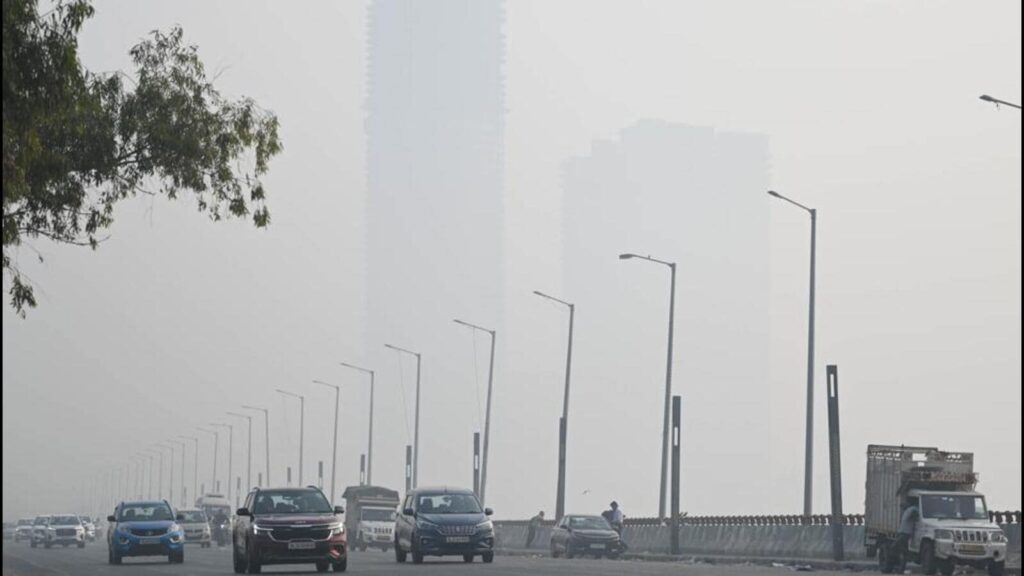‘Very poor’ air chokes Delhi third day running | Latest News Delhi

Delhi’s air quality remained perilously close to plunging into the “severe” category, marking a third consecutive day in the higher end of the “very poor” range on Tuesday. The city’s 24-hour average Air Quality Index (AQI) stood at 373, slightly down from Monday’s 381, but still signalling a critical pollution trend as calm winds and seasonal conditions exacerbate pollutant build-up.

Experts from the India Meteorological Department (IMD) warn this stillness in the air will continue to make the dispersal of pollutants increasingly challenging in the coming days, especially as winter tightens its hold, allowing particulate matter (PM2.5 and PM10) to accumulate to hazardous concentrations.
“Even now, the climatic conditions are not significantly changing,” said a senior IMD official.
“Wind speeds are dropping at night, while daytime gusts remain low at 5-7 km/hr, with fluctuations in direction. As temperatures dip further, the likelihood of severe AQI spikes rises,” they said, noting that forecasts suggest this pattern may hold through November 8.
However, there appears to be some silver lining to the clouds of haze.
Historically, data from the Central Pollution Control Board (CPCB) shows that by early November, Delhi’s AQI has typically already spiked to “severe” levels at least once since 2015.
However, a spell of post-Diwali winds and unusually high October temperatures have kept the city from crossing this threshold — for now.
CPCB classifies AQI between 0-50 as “good”, between 51 and 100 as “satisfactory”, between 101 and 200 as “moderate”, between 201 and 300 as “poor”, between 301 and 400 as “very poor”, and over 400 as “severe” – considered a final a tipping point with stark health consequences, especially for vulnerable populations.
With wind speeds remaining minimal for most of Monday night and on early Tuesday, the season’s first official fog event of the season was reported on Tuesday morning – visibility plummeted to 800m at Safdarjung between 7 and 7.30am.
Visibility between 500m and 1000m is classified as ‘shallow’ fog. Met officials said fog is slight delayed this year, with the first shallow fog generally spell occurring in the last week of October.
IMD data showed last year, the first fog of the winter season was reported on October 31, while in 2022, it occurred on October 12.
“Fog formation depends on the meteorological conditions. One needs sufficient moisture and calm winds to lead to fog formation. Normally, we see our first fog of the season in the last week of October,” said RK Jenamani, scientist at IMD.
The Capital’s monitors show alarming consistency in terms of pollution. By 4 pm on Tuesday, at least 10 of the 40 ambient air quality stations recorded “severe” readings, including Anand Vihar and Wazirpur, both over 425. Anand Vihar, Wazirpur, Jahangirpuri, and Ashok Vihar have all now registered severe AQI levels for three days straight.
Forecasts by the Centre’s Early Warning System for Delhi (EWS) said conditions will remain unfavourable for dispersion, but no significant change is expected in AQI. “Delhi’s air quality is likely to remaubin the ‘very poor’ category from November 6 till 8,” said the EWS bulletin on Tuesday.
Data from the Centre’s Decision Support System (DSS), meanwhile, showed the contribution of stubble burning to Delhi’s air on Monday was 23.3%, up from 19.7% a day earlier.
The seasonal stubble burning that spikes each autumn also continues to add to the city’s airborne pollutants, contributing 23.3% of Delhi’s PM2.5 load on Monday, up from 19.7% on Sunday, according to the Centre’s Decision Support System.
Experts say that while current weather patterns have temporarily delayed severe pollution levels, this relief is tenuous.
“Despite Diwali on October 31, strong winds and higher than normal temperature have helped Delhi dissipate pollutants in a matter of hours. This year, the overall temperature has also been higher throughout October, not just at the end of the month. However, one has to realise that AQI was still touching ‘very poor’ even in October, which means our background emissions are high and it will only take a further dip in temperature to possibly touch severe,” said Anumita Roychowdhury, executive director, research and advocacy.
Both maximum and minimum temperature were above normal on Tuesday. The minimum stood at 17.6°C, two notches above normal and a degree higher than Monday’s low. The maximum was 32.6°C, also two degrees above normal and 0.5°C higher than Monday’s maximum. Forecast for Wednesday shows shallow fog is likely in the early hours, with the maximum and minimum to hover around 33 and 17°C respectively.




